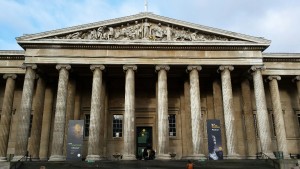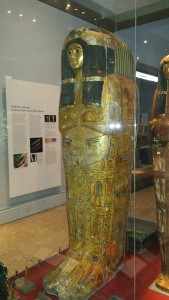Earlier this week I spent some very happy hours at the British Museum. It is years since I went to the BM and, while age may have withered me, it has certainly not staled her infinite variety.
certainly not staled her infinite variety.
Her immediate surroundings haven’t changed that much. Great Russell Street is somewhat less congested by traffic than it used to be. The joke shop which used to be opposite the front gate of the Museum – source of many a school-trip whoopee cushion or stink bomb, to be first used, then confiscated, on the coach home – is no longer there. But the black railings are the same, as is the entrance.
I last visited the museum since the Great Court was covered and the venerable Reading Room restored. So that vast, sheltered space isn’t new to me, even if I can remember the preceding arrangement. But now it’s the norm, hung with banners advertising the latest exhibitions and containing customer information dolmens, two reception  desks and a desk for audio-guides. Sadly, the Reading Room itself is no longer open and its future is uncertain. When it reopened in all its restored glory it was free to the general public and contained books on the exhibits and cultures represented in the Museum. It was re-launched in 2007 as an exhibition space and, once the Museum opened a separate exhibition centre, was redundant as such. I hope its next incarnation will be as useful, and as free, as the interior of the room was beautiful.
desks and a desk for audio-guides. Sadly, the Reading Room itself is no longer open and its future is uncertain. When it reopened in all its restored glory it was free to the general public and contained books on the exhibits and cultures represented in the Museum. It was re-launched in 2007 as an exhibition space and, once the Museum opened a separate exhibition centre, was redundant as such. I hope its next incarnation will be as useful, and as free, as the interior of the room was beautiful.
The school trips haven’t changed much. There were plenty of potential ‘archeologists of tomorrow’ in the Museum when I was there. Some were snaking along in uniformed crocodiles, others were scattered about the floor with books and pencils or crayons. Mostly junior school pupils at this time of year, they were bouncing with enthusiasm. The Egyptian Galleries seemed to be permanently full of them, especially Rooms 62 and 63, containing displays of mummified remains and the exquisitely decorated casings which contained them. This was the gallery I remember heading for when I was about twelve years old and with my school. It was also where, years later, one stood a  good chance, as a teacher, of being able to round up a few missing teenagers, who had wandered off, full of intellectual curiosity (and the desire for a quick smoke out the back – the rear entrance was nearby).
good chance, as a teacher, of being able to round up a few missing teenagers, who had wandered off, full of intellectual curiosity (and the desire for a quick smoke out the back – the rear entrance was nearby).
What could be better than real human mummies? I heard one museum employee ask on Tuesday. The piping reply was almost unanimous. Cat mummies!
In the interests of fairness, I should report that there were also a couple of chirping voices raised on behalf of crocodile mummies. I confess that, even now, a tiny statue of Bast, the cat goddess, sits on a shelf in my living room – it was purchased from the museum shop at least twenty years ago. Next to it is a blue ceramic statue of the eagle-headed Horus, given to me by a visiting scholar and civil servant from the University of Cairo, that is of similar vintage.
The BM is still one of the best places to visit in London, if you have a few hours, or a few days, to spare. About 7 million people thought so last year (the BM regularly features in the top three most-visited museums and galleries in the world). There are free ‘eye-opener’ tours daily from between 11.00 a.m. and 15.45 pm. – details can be found on the web-site.
The collection has expanded since the 71,000 ‘curiosities’ belonging to Sir Hans Sloan were bequeathed to the nation in 1753. It now contains over 13 million objects and its off-shoots – the British Library and the Natural History Museum ( both originally part of the BM ) contain 70 million and 150 million respectively. On-line, the BM web-site has the largest free database of objects in the collection of any museum in the world, with well over three and a half million individual objects listed, many of them illustrated. Check out the web-site here. Over twenty million people did so last year.
I will be writing, in the near future, about the exhibitions I saw and gallery talks I attended. Apologies to Shakespeare for mangling Enobarbus’ description of Cleopatra and to Kate Atkinson, for my stealing part of the title from her excellent novel ‘Behind the Scenes at the Museum‘.
If you enjoyed reading this piece you might also like All of this belongs to you – it’s free Waterloo Visit to the Leighton House Museum


 RSS – Posts
RSS – Posts
One response to “Scenes at the Museum”